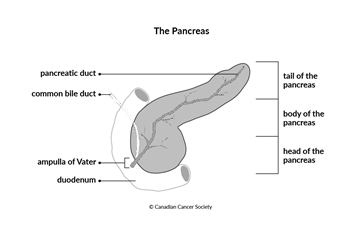What is pancreatic cancer?
Pancreatic cancer starts in the cells of the pancreas. A cancerous (malignant) tumour is a group of cancer cells that can grow into and destroy nearby tissue. It can also spread (metastasize) to other parts of the body.
Cells in the pancreas sometimes change and no longer grow or behave normally. These changes may lead to non-cancerous (benign) tumours such as a pancreatic pseudocyst or serous cystic neoplasm (SCN).
Changes to cells of the pancreas can also cause precancerous conditions. This means that the abnormal cells are not yet cancer, but there is a chance that they may become cancer if they aren’t treated. The most common precancerous conditions of the pancreas are mucinous cystic neoplasm (MCN), intraductal papillary mucinous neoplasm (IPMN) and solid and pseudopapillary neoplasm.
But in some cases, changes to pancreatic cells can cause cancer. Most often, pancreatic cancer starts in cells of the pancreatic duct. This type of cancer is called ductal adenocarcinoma of the pancreas. About 95% of all pancreatic cancers are ductal adenocarcinomas.
Rare types of pancreatic cancer can also develop such as adenosquamous carcinoma.
Another rare type of tumour can start in endocrine cells in the pancreas. These types of tumours are called pancreatic neuroendocrine tumours (pNETs). Depending on how different the cells are from normal cells (differentiation) and how fast the cells are growing (grade) these tumours can be classified as a precancerous or cancerous tumour (called pancreatic neuroendocrine carcinoma). Find out more about pancreatic neuroendocrine tumours (pNETs).
The pancreas is a flat, pear-shaped gland behind the stomach. It is part of the digestive system. The pancreas is also part of the endocrine system. The endocrine system is the group of glands and cells in the body that make and release hormones (which control many functions such as growth, reproduction, sleep, hunger and metabolism) into the blood.

Structure
The pancreas is about 15 cm (6 in) long. The widest part is called the head. The narrowest part is called the tail. The middle part is called the body.
The pancreas has a series of small tubes that drain into the pancreatic duct. The pancreatic duct joins the common bile duct and empties into the duodenum. The duodenum is the first part of the small intestine that receives partially digested food from the stomach, absorbs nutrients and passes digested food to the jejunum. The duodenum also receives bile (a yellow-green fluid that helps digest fat) from the liver and gallbladder.

Function
The pancreas is made up of exocrine cells and endocrine cells. These cells have different functions.
Exocrine cells
Most of the cells in the pancreas are exocrine cells. Exocrine cells make and release pancreatic juice. The juice travels through the pancreatic duct into the duodenum. Enzymes in the pancreatic juice help digest fat, carbohydrates and protein in food.
Endocrine cells
A small number of the cells in the pancreas are endocrine cells. They are arranged in clusters called islets, or islets of Langerhans. The islets make and release insulin and glucagon into the blood. These hormones help control the level of sugar, or glucose, in the blood.
Insulin lowers the amount of sugar in the blood when the blood sugar is high. It stimulates the liver, muscles and fatty tissues to absorb and store the extra blood sugar.
Glucagon increases the amount of sugar in the blood when the blood sugar is low. It stimulates the liver and other body tissues to release stored sugar into the blood.
